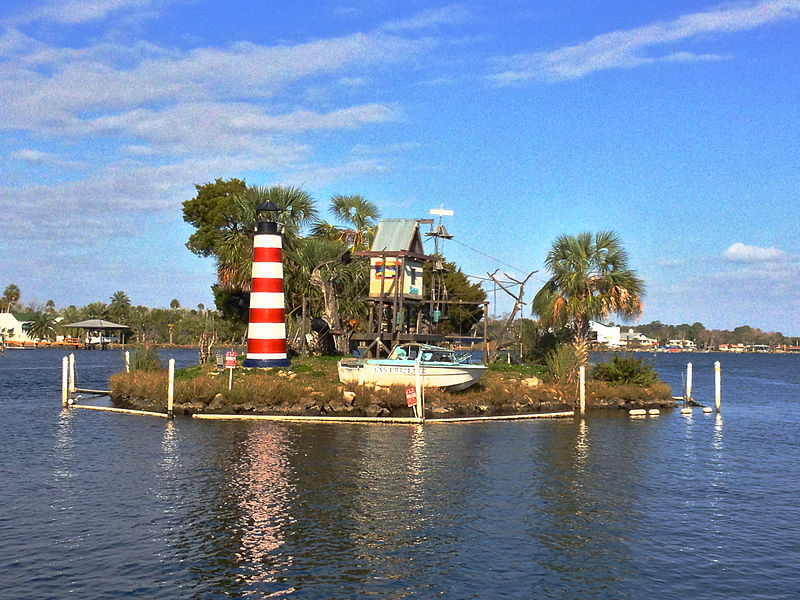The Tale of Monkey Island

Pictured above is an island on the Homosassa River, which flows into the Gulf of Mexico from Florida. (Here’s a map.) The island is a little bit strange if you look at the details — here’s a bigger version of the picture — as there’s a lot going on for such a small dot of land. There’s a lighthouse, a beached little boat, and what looks like to be some sort of playground or jungle gym with an elevated clubhouse. It’s probably a lot of fun to play there if you’re around eight years old or so.
But kids aren’t allowed there. No visitors are, in fact. That’s because the island above is a prison.
For monkeys.
The story of this island began as nothing more than a pile of rocks, but one unfortunately located in an inconvenient place. Back in the 1950s and 1960s (and still today), the Homosassa was a great place to fish. Unfortunately, our pile of rocks became an issue. As Fox 13 Florida explains, “those rocks were shallow enough for boats to run into, and deep enough where fisherman couldn’t spot them with the naked eye.” Fishing boats kept running into the rock pile, and that was bad for everyone involved (except maybe the fish). So in the 1960s, a local developer named G.A. Furgason took action, and per Fox 13, “directed one of his dragline operators to pile some dirt around the rocks for boaters to spot them and avoid a collision.” But they piled way too much dirt on the rocks, creating an island that was a bit of an eyesore. Furgason had a lighthouse built on the island and planted some trees, and otherwise left the island barren, deciding to focus on other projects instead.
One of those projects was the Homosassa Springs Wildlife State Park, an attraction being developed by Furgason’s employer. Located right near the river, the park was intended to be an enclave of animals and plants from around the region, but opportunity knocked and Furgason answered. A polio researcher named Dr. John Hamlet had been testing improvements to vaccines on some monkeys in South Dakota, but his research had finished, and he had nowhere for his monkeys to live. He connected with Furgason and found a solution — relocate the monkeys to the new wildlife park. But there was a problem, as Atlas Obscura explains:
It’s fairly common knowledge that monkeys and their hijinks can be amusing, but they are clearly also a giant pain in the [butt]—and these particular monkeys were exceptional escape artists and a special sort of obnoxious. After several run-ins with tourists that included swiping candy from children, breaking into cars, and taking bites out of trusting, food-offering hands, Furgy was up to his ears in monkey business and repeatedly stated he wished he could send the little hooligans to Alcatraz.
That’s when Furgason realized he actually had a little Alcatraz-like island ripe for the monkeying — his lighthouse-and-dirt rockpile sitting in the nearby river. Not being cruel, he didn’t just dump the monkeys there — he, a developer, turned it into a monkey playground. It didn’t go quite well at first — per Atlas Obscura, “trees originally planted had to be replaced with some that were a little less delicious to the monkeys, huts built to act as homes needed to be rebuilt a little more durable” — but ultimately, the island turned into the monkey habitat seen above. The original monkeys are no longer with us but new ones have been moved to the place now known as “Monkey Island.”
But if you want to play with the monkeys, sorry — they’re not allowed to leave and people aren’t allowed to visit. As Roadside America explains, “surrounding water discourages the monkeys from leaving, and a ring of floats and barriers discourages boaters and kayakers from landing on the island or approaching the animals. Numerous signs warn that trespassing or feeding the monkeys is illegal, and that the island is under 24-hour video surveillance.” Except for the staff that feeds the monkeys twice a day, people don’t go to Monkey Island. You can cruise past it to get a look or go to a nearby dock, but the island playground is for monkeys only.
Bonus fact: Actually, instead of a bonus fact today, let’s go with a long read because it’s really a fantastic story and it’s spot-on, okay? Great! Apparently, relocating retired lab test primates to islands isn’t unique to the story above. In the 1970s, American researchers tested treatments for hepatitis B on some and, when the experiment was over, dropped 66 chimpanzees to an island in Liberia — but unfortunately, the chimps never learned to find food for themselves in the wild. The team that moved the chimps there set up facilities to help keep the animals fed, but when war broke out in the region, the researchers returned to America. A volunteer named Joseph Thomas stepped in to take care of the chimps — and kept doing so for forty years. The Washington Post tells his story in this 10-minute long-read from 2019. (That’s a gift link; it should get you past the Washington Post’s paywall.)
From the Archives: What Happens When a Monkey Takes an Awesome Picture of Itself: A story of… copyright law?
